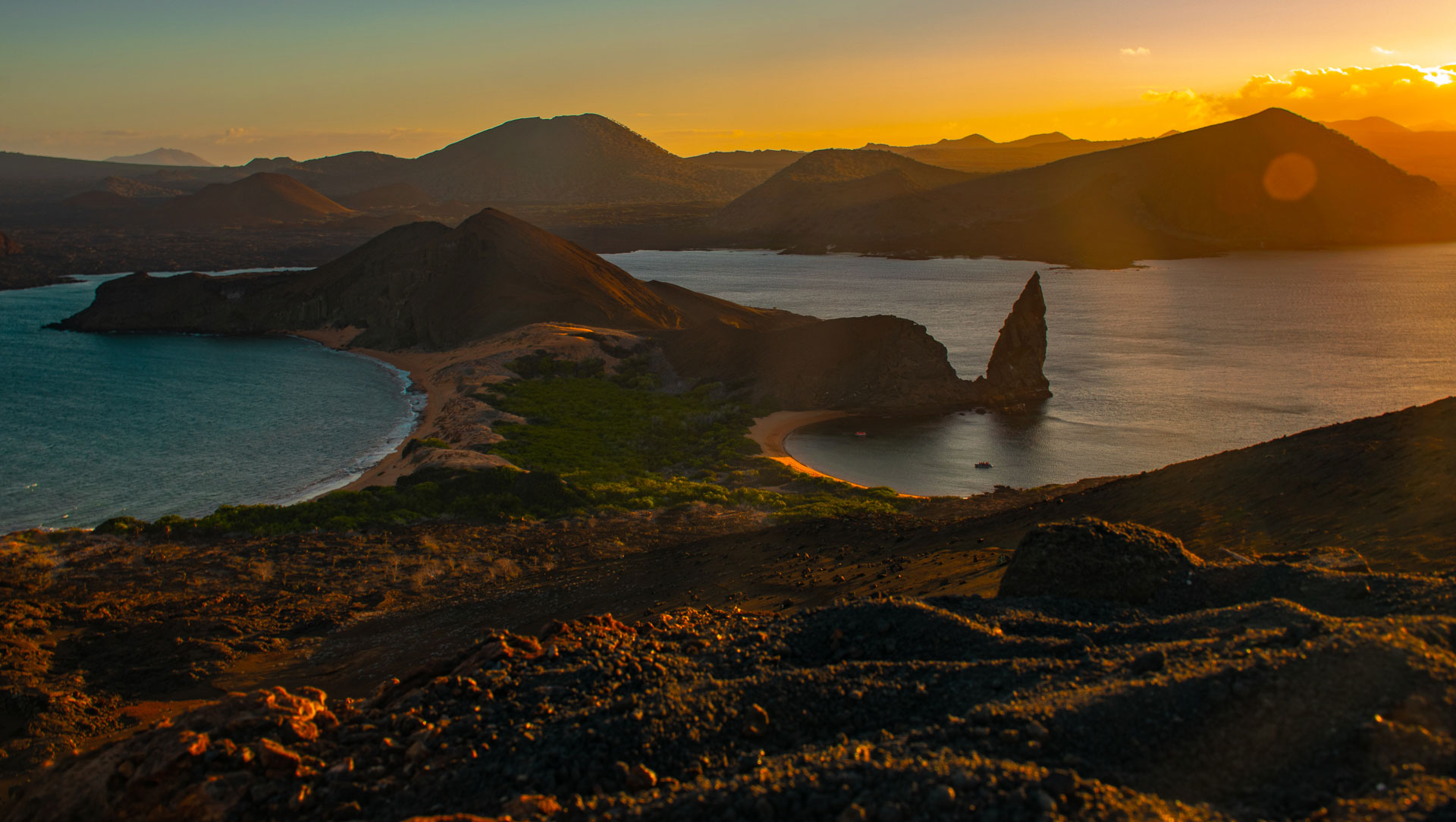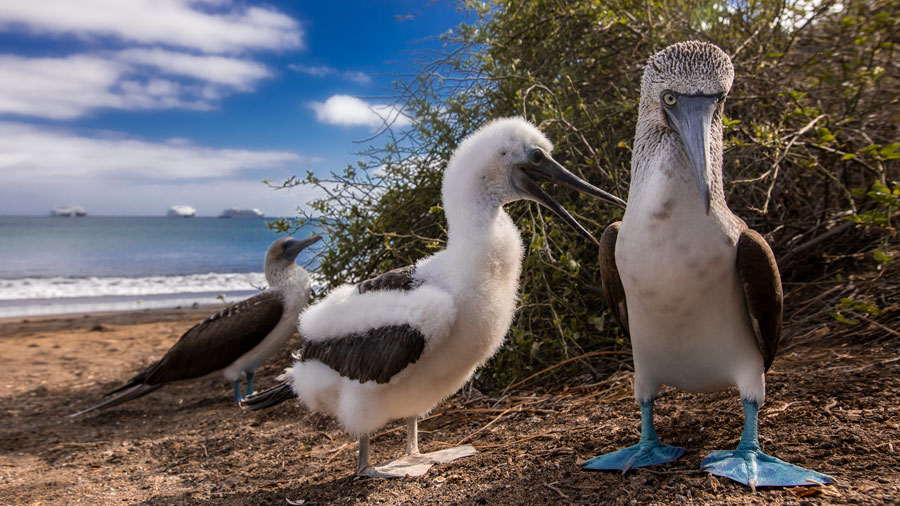LUXURY PACKAGES
Galapagos Climate & Best Times to Visit the Galapagos Islands
Galapagos Climate & Best Times to Visit the Galapagos Islands
GALAPAGOS CLIMATE & THE BEST TIMES TO VISIT
The Galapagos Islands are on the Equator and the climate does not vary dramatically over the year, though there are two distinct seasons: 1) Sunny, warmer and rainier, from December to May and 2) Cloudy and cooler from June to November. The climate of the Islands can best be described as subtropical. There is, however, some variation driven mainly by the ocean currents.
Galapagos Climate December to May can be best described as the warm season. This period brings a unique mixture of warmth, sun, and afternoon rain showers. The water is also warmer, clearer, and calmer during this season.
The average temperatures for the season:
|
December to May |
Temperature | 80ºF to 90ºF | (27ºC to 32ºC) |
| Water Temperature | 70ºF to 80ºF | (21ºC to 26ºC) |
Galapagos Climate June to November can be best described as the cool season. This season also makes a unique mixture in the climate, usually; cloudy, cool, and dry. The Humboldt Current is responsible for this; it brings a cooler current to the Islands, thus making both the water and the land cooler.
The average temperatures for the season:
|
June to November |
Temperature | 80ºF to 90ºF | (27ºC to 32ºC) |
| Water Temperature | 70ºF to 80ºF | (21ºC to 26ºC) |
|
Month by Month Temperatures |
Month | Jan | Feb | Mar | Apr | May | Jun | Jul | Aug | Sep | Oct | Nov | Dec |
| average max | 86 | 86 | 88 | 88 | 79 | 79 | 79 | 79 | 79 | 81 | 82 | 84 | |
| average min | 72 | 75 | 75 | 75 | 72 | 70 | 66 | 66 | 66 | 68 | 70 | 72 |
ABOUT THE GALAPAGOS ISLANDS
The “Enchanted Islands”
The Galapagos – The Middle of the World
Lying 970 km (600 miles) west of the Ecuadorian coast on the equator, the Galapagos Islands consist of 6 main islands, 12 smaller islands and over 40 small islets.
The Galapagos Islands are an archipelago of volcanic islands that originated about 10 million years ago.
Since their formation 10 million years ago, to their discovery in 1535 by Thomas de Berlanga, the Spanish Bishop of Panama, the Galapagos Islands were completely isolated from the mainland. Throughout the millennia, a large number of birds, reptiles, insects, and plants drifted or flew to its shores, creating the unique flora and fauna found in the Galapagos today. The Islands have never been connected to a continent, therefore, over time, species have developed and adapted to the unique ecosystems of the Islands. Many species continued on and soon began to differentiate from their continental ancestors resulting in the development many endemic species (not found anywhere else) on the Islands. Until recently, the animals on the Islands had no exposure to humans and therefore never learned to fear them and remain extremely tame in human presence.
At the culmination of his journey around the world with the HMS Beagle (1831-1836), the English scientist Charles Darwin, arrived at the Galapagos Islands in September 1835. The scientific findings he made during his stay at the Galapagos built the basis of his essay “Origin of Species by Means of Natural Selection” that completely changed the course of biological science.

Lying 970
When you visit the Galapagos Islands you will quickly understand why the Spanish pirate Diego de Rivadeneira named the Islands “Las Islas Encantadas” (The enchanted islands). The Islands are filled with prehistoric looking land iguanas, 11 different species of giant tortoises, which give the Island their name (galapago means tortoise in Spanish), mocking birds pecking at your shoe laces, curious sea lions playing with you while you snorkel. There are 13 species of endemic finches (the famous Darwin’s finches), moon like landscapes and mist-covered volcanic peaks, red sand beaches, strange forests of prickly pear cactus, the world’s pinkest flamingoes (!), the biggest breeding-colony of albatrosses in the world, blue-footed boobies performing their “sky pointing” dance, and hunting penguins swimming around your legs. These Islands are truly enchanting.

The Galapagos Islands are famous for the rare species found on the islands. All the reptiles, half of the plants, and 40% of the birds are endemic to the Galapagos.
Our boats will take you to many of the different Islands. Each stop provides the incredible opportunity to go snorkeling among playful Sea lions, Dolphins, Sharks (totally safe!), innumerable tropical fish, and giant Manta Rays. You will also have the opportunity to watch the amusing red- and blue- footed boobies, huge land iguanas, and all the other endemic animals on the Island. The boats offer shore excursions where you can explore the different Islands, admire the unique plant life and animals, and be filled with information from an English speaking naturalist guide. There is never a dull moment in the Galapagos. We have many different boats that will satisfy all your needs. From smaller motor sailor yachts, to economy and luxury cruises. Imagine, plentiful sun, warm breezes, crystal clear water, and an abundance of flora and fauna; our boats are an excellent choice for enjoying the Galapagos Islands.
We also offered you our combined tours to the Islands, an attractive alternative to enjoy the Galapagos Islands with your family or friends. These tours offer you a chance to explore the different Islands of the Galapagos and stay at a near by hotel. We offer numerous tours to fit all of your needs. On our combined tours you will have the opportunity to see what these enchanted Islands have to offer such as, sea lions, tortoises, iguanas, different marine species, as well as other flora and fauna . In addition, you could see all the highlights of the Galapagos and enjoy a stay in beautiful accommodations.
